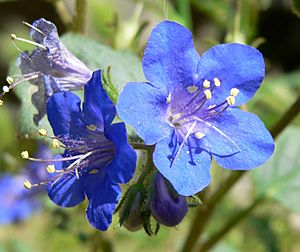Parry's phacelia facts for kids
Quick facts for kids Parry's phacelia |
|
|---|---|
 |
|
| Scientific classification | |
| Genus: |
Phacelia
|
| Species: |
parryi
|
Phacelia parryi is a beautiful wild flower often called Parry's phacelia. It belongs to a group of plants known as phacelias. This plant is an annual herb, which means it grows from a seed, flowers, produces new seeds, and then dies all within one year.
Where Parry's Phacelia Lives
Parry's phacelia is native to sunny southern California and Baja California in Mexico. You can find it growing in different places like coastal areas, mountain ranges, and even deserts. It likes many types of local habitats, such as coastal sage scrub (a type of plant community), chaparral (dense shrubs), and open slopes that have recently experienced a wildfire. Sometimes, its range might even stretch into Arizona.
What Parry's Phacelia Looks Like
This plant usually grows a stem that stands upright, reaching about 10 to 70 centimeters (about 4 to 28 inches) tall. The stem feels a bit sticky because it's glandular (meaning it has tiny glands), and it's covered in both soft and stiff hairs.
Leaves and Flowers
The leaves of Parry's phacelia can grow up to 12 centimeters (about 5 inches) long. They have an oval shape with jagged or "toothed" edges. These leaves are attached to the stem by small stalks called petioles.
The flowers grow in a cluster called an inflorescence, which looks like a loose group of bell-shaped blooms. Each flower is about 1 to 2 centimeters (less than an inch) long and has a lovely purple color. Sometimes, the center of the flower might be a lighter shade. A cool feature is that each flower has five distinct white spots! Inside the flower, you'll see five stamens (the parts that produce pollen) sticking out. These stamens are hairy and have white tips called anthers.

